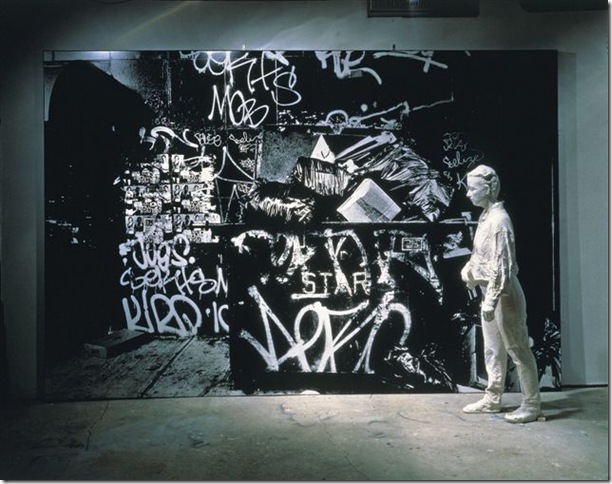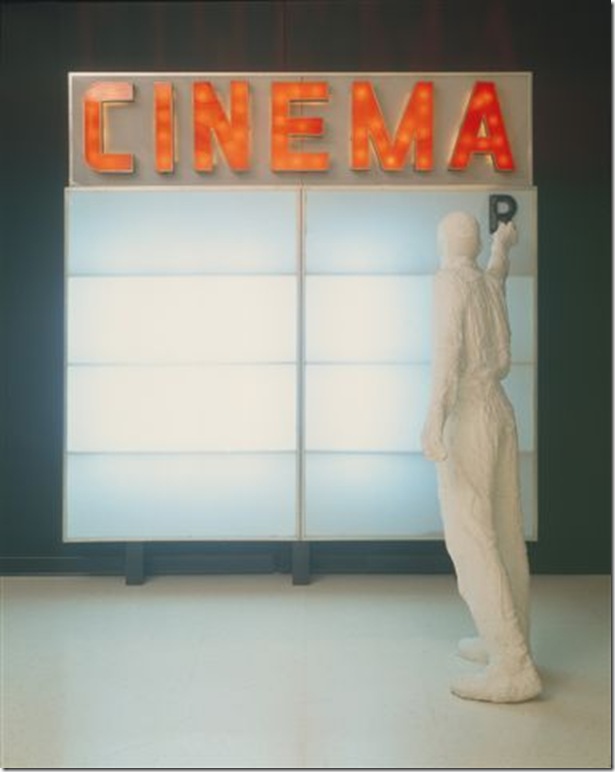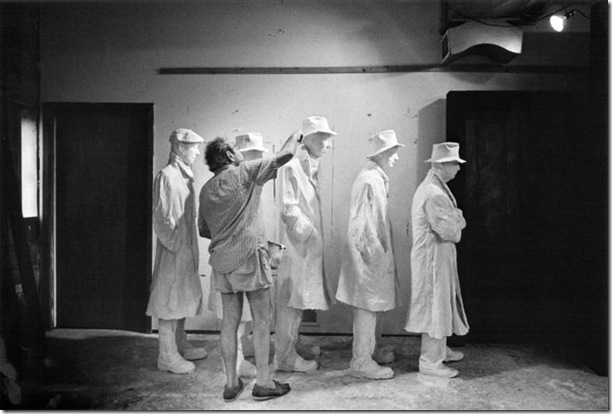Four tractor-trailers hauled thousands of pounds of George Segal’s sculptures from Dallas to West Palm Beach. This is worth noting because an exhibition of his work, now at the Norton Museum of Art, presents 16 installations in a modest corner gallery of the museum’s first floor.
For all of its physical weight, George Segal: Street Scenes is not a sprawling sort of show, the kind that meanders through themes and rooms, where works are passed over because there is simply too much beckoning for our attention.
Although intimate, the exhibit is substantial in its pensive views of what it means to work and live in the heart of Urbania. Assembled in largely monochromatic vignettes, the plaster and bronze city dwellers made by Segal between the early ’60s and the late ’90s convey fragmented — often solitary — people and nooks from the real world, and they are both precise and encompassing.
It was one of the late American artist’s gifts — to be able to construct a human form blank enough for us to project our own questions upon but one that is also accentuated with detail — the buckle of a shoe, the ripple of a woman’s skirt, buttons and bare knuckles emerge from Segal’s ghostly palette.
We see this vital conflation with Japanese Couple Against Brick Wall, a 1981 installation depicting a man and a woman standing close together and seemingly anxious in their postures: his feet are askew as he leans into her shoulder, and she wraps an arm around her waist while one hand tugs at her chin.
Ensconced at the entrance of the show, they appear as guides, but if passed on the sidewalk, on the way elsewhere, the pair might only be briefly noted amid the downtown crush of apartment buildings and traffic. With their ordinary attire and barely-there eyes, this man and woman are at once familiar and mysterious, and at the museum, we recognize their presence even as we wonder what it means.
Segal (1924-2000) was enormously inspired by the ordinary minutes of the lives he encountered growing up in New York and, later, while living in South Brunswick, N.J. The street corners and diners he dramatically fashioned in his work were the very places he would frequent.
For years he traveled by bus to Manhattan, camera in hand, to what was then the poorest or humblest of neighborhoods: the Bowery, the East Village, or any place that was home to common folk. These were the people he wanted to document, not literally but through a reimagining that washed them in chalky plasters and blue and green patinas.
Segal’s men and women ride subway cars, gather on crosswalks, or sit on the front stoop of a liquor shop. His props are spare but suggest more than everyday settings. Many of his pale statues are framed by walls, doors or windows — key elements in Segal’s theater — that obstruct a way out or divide individuals from the troubles of their lives. In Parking Garage, a young man sits hunched before a sealed exit, pondering the day’s events or perhaps the evening ahead. He appears exhausted and we come across him in a rare instance of work-day stillness.
The Norton has smartly set up seating in an adjacent corner, and throughout the show, giving visitors a chance to join the tableaux, which are not simply meant to be looked at as much as to be experienced. We need to spend time with Segal’s people in order to understand them or to empathize with their plights — much as he did.
These sculptures work differently up close than at a distance. From afar, light and shadow give each piece the feel of a documentary film still — the impression is objective, almost scientific in its attention to how people exist in cramped proximity to one another. We either escape into the city’s quieter pockets or we pass one another without meeting eyes.
Move closer to his studies, and Segal’s compassion emerges. We feel it because of his attention to meager details: the construction of the threadbare blankets of two homeless men or how he drizzles sleet down the thin coats and hats of those shivering in a Depression-era bread line. Countertops and doorways are salvaged from junk stores; sculptures are cast from the bodies of friends, family or even from his own slumping shape. Everything matters.
In these narratives, Segal is not only a chronicler of isolation or despair; he is also moved by what he sees. He is the eye and he is what stands before it.
Emma Trelles is an arts writer in South Florida.
GEORGE SEGAL: STREET SCENES runs through Dec. 6, along with New York, New York: The 20th Century (through Dec. 27); and William Kentridge: Five Themes (through Jan. 17). The Norton Museum of Art, 1451 S. Olive Ave., West Palm Beach. Hours: 10 a.m.-5 p.m. Tuesday-Saturday and 1-5 p.m. Sunday. Closed Mondays. Admission: Adults $8, ages 13-21 $3, and ages 12 and under free. Call 561-832-5196 or visit www.norton.org.



